Garden Tip of the Week: January 3, 2019
“How NOT to prune nandinas!”
Nandinas are some of our best landscaping shrubs. Why is it, then, that we mangle them the way that we do with our pruning tools?
I think I can explain.
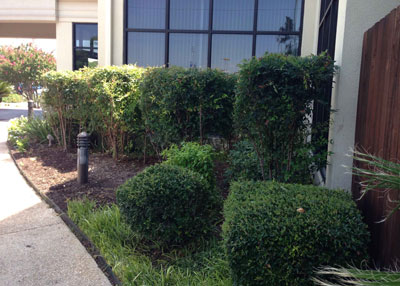
These nandinas outside a hotel where Lynn and I were staying in San Antonio were being cut into very unnatural square shapes. All of the shrubs in that landscape, nandinas and otherwise, were shaped like green boxes.
Nandinas are shrubs. We’re used to shrubs that produce branches. When we prune those branches, the plants send out new branches in their places. We start with five branches, and following pruning, we end up with 15 or 20.
Well, nandinas don’t do business that way. They don’t produce branches. They send up robust shoots with rosettes of foliage. Along the style of a palm tree. However, unlike most types of palm trees, nandinas send up new shoots from their bases. They form clumps of unbranching stalks, and it’s that growth that keeps the plantings full and attractive.
That’s where the rub comes in. People take out their hedge trimmers and they flat-top or round out their nandinas without regard for the fact that that’s the way they’re going to look from that time forward. If you cut their stems and leave square plants in the process, you’re going to have square plants forever.
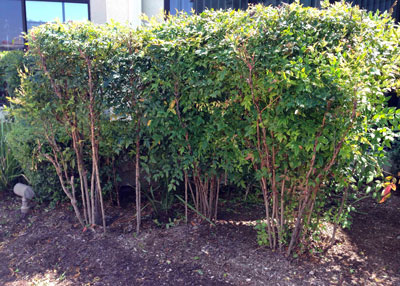
You can see the square-ish shapes, and you can see the bare stems at the bottoms.
The REAL WAY to prune your nandinas…
If you look at a bed of vigorous nandina plants, almost regardless of the variety, by the end of the growing season it’s going to have a percentage of its stems that extend above the bulk of the plants’ canopies.
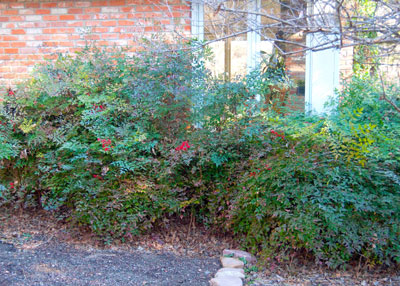
These Nandina domestica ‘Compacta’ plants in our landscape grow too tall over the summer each year. By winter they extend up into the windows. I can look at this photo and show you 20 or 25 stems that will be removed. You can see the basic body of the foliage at two-thirds the height of these plants. By removing the tall stems completely to the ground, the planting will be evened up and new shoots will come up from the ground to prevent bare stems. We’ll clean out the dead leaves and spread a new layer of mulch. Life will be beautiful again. We repeat this each winter.
Let’s say you wanted the bed to mature at 36 inches, but you can clearly see that one-third of the canes are taller than that. Here’s what you need to do.
• Use long-handled lopping shears so you can cut one stem at a time. Mid-winter (now) is the ideal time.
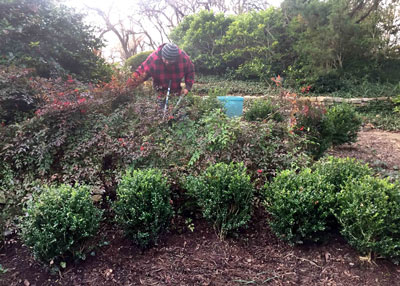
Using long-handled lopping shears, identify erratic and tall canes, then trim them back the ground. Lift them out and discard them.
• Reach into the planting and cut the tallest cane to within 1 inch of the soil line.
• Step back and look at the bed to see what impact you’ve made.
• If you see a second cane that’s grown too tall, cut it back, too.
• Repeat the process until the planting looks exactly as you wanted it. If you do the work properly you’ll hardly be able to tell that you’ve done any removing.
• Each of those cut canes will send up new shoots in the spring. Since they’ll be coming up from the roots they’ll fill in the bare spaces below.
• Repeat the process each winter, preferably in January or early February, and your nandinas will stay compact and handsome.
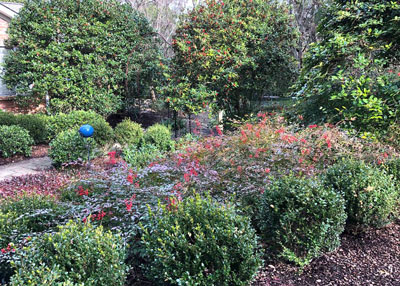
This is the same bed being pruned in the photo shown earlier, but photographed from the opposite direction just three days ago. Notice how uniform the stem heights are after 11 months of regrowth. This is what you’re seeking. Honestly, this planting of nandinas probably won’t need as much pruning this year. Click image for larger view.
Note: The exceptions to all this are the old Nana nandinas and others like them. They have a different form of growth: dwarf and actually often rather stunted – also highly colored in winter. It’s probably better if you don’t do any pruning at all to them unless you need to address dead or damaged branches.

[…] https://neilsperry.com/2019/01/garden-tip-of-the-week-january-3-2019/ […]